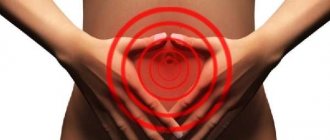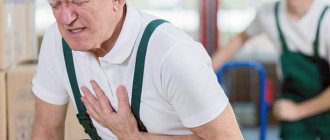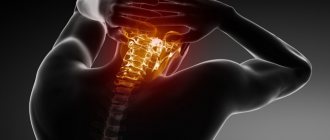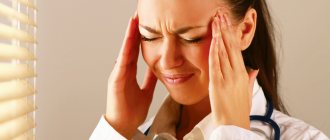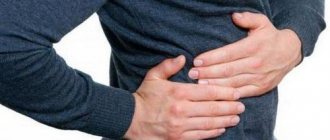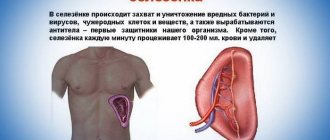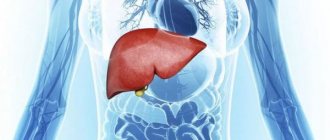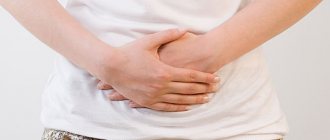Unpleasant sensations in any area of the epigastrium may indicate the development of many diseases and pathological conditions. If pain occurs in the left hypochondrium, people suspect a malfunction of the spleen or pancreas. Sometimes these assumptions are justified, but there are other ailments that cause discomfort in this area.
Causes and nature of pain
If your left back hurts regularly under your ribs, you need to seek help as soon as possible. The reasons can be different - from bruises to stenosis and oncology. The nature of the back pain on the left under the ribs is the first indicator of the cause of the syndrome:
- girdling;
- shooting;
- aching;
- pulsating.
The pain syndrome can radiate to the right half of the back, neck, lower back, abdomen, and shoulder blade.
Diseases of the musculoskeletal system
When your back hurts in the back left under the ribs, first of all you pay attention to the condition of the spine. Pain in back diseases can spread to the hypochondrium, arms, legs, depending on the affected area. The cause of back pain on the left under the ribs is pinched nerve roots and muscle spasm.
This happens with osteochondrosis and intervertebral hernias. Nature of pain:
- sharp lumbago;
- aching, deep pain in the left hypochondrium, which radiates to the back;
- the pain radiates to one leg, especially when walking.
If the cause of pain in the left hypochondrium, radiating to the back, is precisely the pathology of the spine, additional symptoms appear. This is muscle stiffness, a feeling of tingling, numbness, “goosebumps” on the skin at the site of the lesion. Tendon reflexes change, sensitivity to touch decreases.
Gastrointestinal diseases
Pain in the left hypochondrium from the back often accompanies diseases of the digestive tract. This syndrome can be caused by an inflamed pancreas. With exacerbation of inflammation - pancreatitis - the pain becomes encircling, affecting the opposite side.
Such pain in inflammatory pathologies of the intestines and stomach can be called atypical. But exacerbation of gastritis or ulcerative lesions can be expressed in this way, although more often the pain radiates to the right side.
Lung diseases
If there is pain on the left under the ribs from the back, you need to pay attention to the condition of the respiratory system. Such pain is caused by lower lobe pneumonia or pleurisy. If the cause is truly in the respiratory system, pain on the left under the ribs on the back side appears when inhaling or when coughing, which inevitably accompanies these conditions.
With a bilateral inflammatory process, the pain is girdling in nature. If you lie on your painful side or back, the discomfort becomes less.
Pathologies of the heart and blood vessels
The most common cause of pain in the left hypochondrium, radiating to the back, is heart and vascular disease, along with pathologies of the spine. Diseases that may be accompanied by such symptoms:
- cardiac ischemia;
- myocarditis;
- pericarditis;
- angina pectoris;
- myocardial infarction.
If a heart attack affects the posterior walls of the myocardium, pain from the back on the left under the ribs spreads to the left arm, shoulder blade, and can radiate to the jaw on the left. Angina pectoris is accompanied by the main focus of pain closer to the center of the chest region and back. The pain seems to penetrate right through not only from the back, but also in the chest.
Types of pain
In addition, pay attention to the characteristics of unpleasant sensations:
- Prolonged pain under the ribs may indicate damage to the kidney structures.
- The pulsating nature of the discomfort, which intensifies with inspiration, is a symptom of damaged lung tissue.
- Dull pain may indicate an inflammatory process in the kidneys or spleen.
- Intense girdle discomfort in the epigastric zone, radiating to the scapula, heart or lower part of the sternum, is a symptom of pancreatitis.
- Acute pain, significantly intensifying during exhalation, most often signals osteochondrosis or intercostal neuralgia.
- Constant burning sensations in the sternum, periodic “lumbago” may indicate an aortic aneurysm.
- Shooting, projective pain is often a sign of damage to the spinal cord and nervous system.
Pathologies of the genitourinary system
Photo from botkin.pro
When the left side hurts from the back under the ribs, pay attention to the condition of the kidneys and ureters in the absence of other symptoms. The kidneys are located in the retroperitoneal region, therefore, with inflammatory and infectious diseases, pain is felt in the lower back and under the ribs.
Pathologies that can provoke this condition:
- glomerulonephritis;
- pyelonephritis;
- stone in the kidney, ureter;
- nephritis;
- ascending infections.
The location of inflammation can only be clarified through diagnostics.
Neuralgia
Pain from the back in the left hypochondrium may be accompanied by intercostal neuralgia. It worsens with inflammation, injury, hypothermia, and the pain radiates sharply when moving. Symptoms are local, similar to spinal lesions.
The pain intensifies when sneezing, coughing, taking a deep breath, or turning. Therefore, patients often breathe shallowly and are constrained in turning their body.
Other reasons
Pain from the back under the ribs on the left can be caused by herpes zoster. The virus affects the muscle fibers between the ribs and nerve roots. The symptoms are similar to neuralgia, but painful, inflamed blisters can be seen at the site of the lesion.
The pain is constant, and not just when moving and inhaling. As the blisters heal, there is severe itching at their location. They leave deep wounds in the skin that heal over time.
Selection of treatment
Since pain on the left side can occur for a variety of reasons, their treatment can only be carried out after diagnosis. By eliminating the cause, it is almost always possible to get rid of pain.
Medication
The choice of drug treatment depends entirely on the type of pathology that provokes pain in the left abdomen. If pain occurs due to diseases of the spleen, then very often there is a need for urgent surgery.
To alleviate the patient's condition and relieve pain, painkillers may be prescribed - Spazmalgon
, Ibuprofen, etc. If bloating is observed,
Espumisan
or
Mezim forte
.
Medications that have an enveloping effect are widely used. Today the most famous drug is De-nol
. When pain is accompanied by heartburn, antisecretory drugs are indicated.
Painkillers from the NSAID group should be taken with caution, as they have a strong irritating effect on the gastric mucosa. In case of severe pain, it is allowed to take No-shpu
or
Nimesil
.
Folk remedies
Although treatment for pain in the left side of the abdomen should always be carried out after diagnosis, some folk remedies can be effective in relieving pain in various conditions. In particular, ginger and fennel based products are considered completely safe options. They can improve a person’s condition when the left side hurts.
Ginger
is a natural antioxidant that has anti-inflammatory properties. It regulates the digestion process and, therefore, eliminates abdominal pain if it is associated with gastrointestinal problems. Ginger is an effective remedy for pain caused by gastritis. A decoction of the root reduces the acidity of gastric juice, which is a provoking factor for pain.
To prepare a healing drink, you need to cut a small root into thin slices and pour a glass of boiling water. After this, the drink must be boiled over low heat for 5 minutes. You can add honey to taste to the decoction that has cooled to room temperature and drink in small sips.
Fennel seeds can help reduce stomach pain associated with gastrointestinal problems.
. This folk remedy helps relieve gas and bloating, which are also common causes of pain.
A drink is prepared from crushed fennel seeds. To do this, pour a teaspoon of the product into a glass of hot water, and then boil the product for 10 minutes over low heat. Add a little honey to the cooled broth and then drink in small sips. To prevent pain associated with eating, it is recommended to slowly chew one teaspoon of fennel seeds immediately after eating.
Chamomile also has pain-relieving properties.
. It allows you to relieve aching pain and relax the muscles of the digestive tract. The most effective is chamomile infusion for food poisoning. To prepare a healing drink, you need to pour a teaspoon of dry chamomile into a glass of hot water, cover and let it brew for 15 minutes. After cooling, you should drink the drink. To improve the taste, you can add honey to it.
Preventive measures
Since the most common causes of pain in the left side of the abdomen are diseases of the digestive system, for prevention it is necessary to eat properly.
The diet should contain wholesome and healthy foods. As little as possible, you should eat hot and spicy foods, which have an irritating effect on the mucous membranes and can cause the development of serious pathologies. It is also important to avoid nervous overload and stress. In addition, it is necessary to lead a healthy lifestyle and get proper rest.
To prevent the occurrence of pain associated with various gynecological diseases, women need to wear comfortable underwear and avoid wearing constrictive clothing. It is very important to undergo regular examinations with a gynecologist. To prevent the development of prostatitis, men should adhere to a healthy lifestyle, give up alcohol and smoking, and also take care of moderate physical activity.
Associated symptoms
Primary diagnosis consists of collecting anamnesis - the doctor asks the patient about complaints and, based on them, makes the first conclusions, based on which he chooses the direction of diagnosis. Symptoms that may accompany back pain in the back left under the ribs if the cause is diseases of the spine:
- tingling, numbness of hands, fingers;
- low sensitivity in the affected area;
- fatigue of arms and legs, weakness;
- muscle spasms.
If the cause of pain in the left hypochondrium and back is pathology of the gastrointestinal tract, additional symptoms manifest themselves as follows:
- nausea, vomiting;
- pain on an empty stomach or after eating;
- poor appetite;
- heartburn;
- flatulence;
- loose stools or constipation.
When the left hypochondrium hurts and radiates to the back, the doctor may suspect pancreatitis. When palpating the abdomen on the left, sharp pain is noted, and sometimes the temperature rises.
In case of lung diseases, the accompanying symptoms are as follows:
- wheezing breathing;
- cough is dry or with viscous sputum;
- pain on inspiration;
- decreased breathing volume;
- dyspnea.
Based on the nature of the cough and sputum, the doctor determines the further direction of diagnosis.
If the pain on the left under the ribs radiates to the back due to heart disease, a number of characteristic symptoms are felt. This is a heavy, palpable heartbeat, a feeling of fear, panic, a rush of heat to the neck and face, cold sweat. Blood pressure and pulse indicators are also affected.
For pathologies of the genitourinary system, additional signs are as follows:
- discomfort when emptying the bladder;
- frequent urge to urinate;
- increased body temperature;
- change in urine color;
- increase in daily urine volume;
- sharp pain when urinating;
- swelling on the face.
Diseases of the kidneys and genitourinary system in general are also often accompanied by increased blood pressure.
What to do if your left side hurts or pulls on the left side
Any action to relieve pain on the left side can only be taken when a diagnosis has been established. Any self-medication can cause serious complications. Quite often the left abdomen hurts due to exacerbation of chronic pancreatitis. This pain occurs after eating fatty foods and may be accompanied by vomiting. To relieve pain, you need to take enzyme preparations to improve digestion. In addition, you can reduce pain if you constantly drink alkaline mineral water without gas, at room temperature.
If your stomach hurts on the left side due to food poisoning, then you can relieve the pain, first of all, by gastric lavage. To do this, you need to use regular boiled water, which you need to drink at least one and a half to two liters at a time. After this, vomiting should be artificially induced. To increase the effectiveness of the procedure, it is recommended to repeat it.
After gastric lavage, it is necessary to restore the water-salt balance. To do this, you should drink at least 2 liters of liquid within 4 hours. It is recommended to add salt to the water at the rate of 1 teaspoon per liter of water.
In most cases, after such activities, the pain subsides. If this does not happen, then it is allowed to take No-shpa
or
Papaverine
.
When your stomach hurts on the left side due to gastritis, it is strictly forbidden to decide on your own to take medications. They must be prescribed by a doctor. The most commonly used astringents are. They form a protective film on damaged areas of the mucous membrane, as a result of which the pain recedes. In addition, with gastritis it is very important to neutralize the effect of hydrochloric acid, which is most often a provoking factor in the occurrence of pain. For this purpose, antacids are prescribed. Such medications interact with gastric juice and reduce its acidity, which helps relieve pain.
Which doctor should I contact for pain in the left hypochondrium from the back?
Pain on the left side from the back under the ribs is a symptom too general to be immediately identified by a specialist. First, you need to contact your family doctor or therapist, who will study your medical history and refer you to specialists:
- spine – orthopedist, osteopath;
- Gastrointestinal tract – gastroenterologist;
- lungs – pulmonologist;
- heart – cardiologist;
- genitourinary system – urologist, gynecologist for women, andrologist for men;
- neuralgia – neurologist;
- herpes zoster – infectious disease specialist, neurologist.
A specialist specialist has already prescribed detailed symptoms.
Left towards center
Acute and chronic pancreatitis
Pancreatitis. The photo can be enlarged.
The nature of the sensations. Severe engulfing pain, burning. It can also appear on the right side. The chronic form is accompanied by dull, aching pain.
- Additional symptoms. Attacks of nausea, increased sweating, abdominal bloating, fever, a feeling of bitterness in the mouth.
- Specific symptoms. “Tea” color of urine, very light stool. The pain “bends” the patient even in a sitting position. Vomiting fluid with bile, yellowish skin.
- Circumstances. Most often after heavy intake of fatty foods, alcohol, or a diet violation.
Diagnostics
To diagnose the causes of pain in the ribs on the left from the back, the following is prescribed:
- general blood and urine tests;
- Ultrasound of the abdominal organs;
- , MRI with a lack of information after ultrasound.
This is a general examination plan, it will also be prescribed for pathologies of the spine - this is enough to detect osteochondrosis, scoliosis, and hernia. If gastrointestinal pathologies are suspected, tests will be prescribed:
- stool for occult blood;
- blood glucose;
- amylase, C-peptide.
Ultrasound helps determine the condition of the pancreas. To evaluate the stomach and intestines, gastroduodenoscopy will be prescribed.
Photo from the site medinvest.zp.ua
For lung diseases, the doctor will prescribe a laboratory test of sputum discharge, as well as an x-ray or fluorography. For diseases of the heart and blood vessels, an analysis is prescribed for ALT and AST, myoglobin, electrolytes, C-reactive protein and lipid profile. A coagulogram and an electrocardiogram, including with exercise or daily, also provide sufficient data.
If pathology of the genitourinary system is suspected, the following will be prescribed:
- vaginal/urethral smear;
- bacterial culture of urine;
- urine examination for protein, density, epithelial particles;
- urine transparency test;
- daily diuresis.
Ultrasound with a contrast agent is also prescribed for diagnosis.
Table of symptoms and causes of abdominal pain on the left
| Abdomen area | Symptoms | Causes |
| 2 – left upper abdomen | Acute pain in the left abdomen, which can radiate to the back | Inflammation of the pancreas due to illness or large amounts of alcohol/cigarettes |
| 3 – left hypochondrium | Frequent belching, burning/tingling behind the sternum | Heartburn due to stress, fuss, high-fat foods, too weak diaphragm muscles |
| 4 – left upper abdomen to shoulder | Pain in the upper abdomen may radiate to the left shoulder | Splenic infarction due to arterial thrombosis or enlarged spleen |
| 5 – left lower abdomen | Stitching pain in the abdomen on the left side | Intestinal diverticulum |
| 4 - left lower abdomen | Acute pain in the left lower abdomen, sometimes back pain | Urolithiasis, passage of stones or sand from the left kidney |
| 5.6 – left side or entire abdomen | Abdominal pain on the left or pain in the entire abdominal cavity, nausea, vomiting, diarrhea | Intestinal infection |
| 6 - left side of the abdomen in the middle | Pain near the navel, in the left or right lower abdomen, vomiting and nausea, digestive problems, fever | Appendicitis |
| 6 - left side of the abdomen in the middle | Pain after eating | Food intolerance (fructose, lactose, gluten intolerance) |
| 7.8 – left lower abdomen | Pain in the left lower abdomen in women, vaginal discharge | Inflammation or cancer of the fallopian tubes, ovaries, or uterus |
| 9 – under the ribs | Chest and shoulder pain, depression, shortness of breath, cold sweat | Heart attack |
| 9 - under the ribs | Chest pain when breathing | Pneumonia |
Attention! Our website provides you with primary information on the topic of left abdominal pain. However, this information cannot replace consultation with a doctor. Any abdominal pain requires medical examination.
Treatment
Pain under the left rib from the back is not a separate disease that requires treatment. This is only a symptom that can be temporarily relieved until the cause is determined.
Analgesics and non-steroidal anti-inflammatory drugs are used to relieve pain. Hormonal painkillers are indicated for acute, unbearable pain; they are prescribed only by a doctor, but you need to understand that such pain is a sign of an emergency condition, and it cannot be relieved until the ambulance arrives.
Analgesics and NSAIDs to eliminate pain in the left hypochondrium from the back of moderate intensity:
- Panadol.
- Ibuprofen.
- Meloxicam.
- Nimesulide.
- Diclofenac.
- Efferalgan.
Diclofenac is best used in the form of an ointment, locally in the affected area. All medications must first be discussed with a doctor, as they have a number of contraindications and restrictions, and in case of stomach pathologies they can greatly worsen the condition. That is why diagnosis comes first.
Pain under the ribs on the left side of the back is a symptom of many inflammatory diseases. The doctor determines the possible cause by the nature of the pain and accompanying symptoms, and laboratory and hardware diagnostics confirm or refute the diagnosis. The sooner the cause is identified, the sooner it will be eliminated and the pain will be relieved.
Author: Vladislava Matveeva, doctor, especially for Vertebrolog.pro
When should you go to the doctor as soon as possible?
Schedule a visit to your therapist soon if your Abdominal pain:
- The pain in the left side is insignificant, but worries regularly, making itself felt for a week or longer.
- Palpable pain comes and goes, and this condition lasts longer than 1-2 days, or is accompanied by nausea and vomiting, or becomes increasingly painful.
- A pulling sensation in the left side of the abdomen is accompanied by a deterioration in appetite, diarrhea that lasts longer than a couple of days, or (option for women) bloody vaginal discharge.
- In addition to discomfort in your left side, you notice that you are losing weight for no apparent reason.
What is located on the left under the ribs?
Remembering the basics of human anatomy, we can confidently list the organs that are located specifically in the area of the left hypochondrium. And it is here that nature has determined the place for the pancreas, spleen, part of the diaphragm and intestines. Therefore, when pain occurs in the hypochondrium on the left, it is almost impossible to immediately say with certainty what exactly caused it. Only a doctor can determine the source of the pain that has arisen, who, before making a diagnosis and prescribing treatment, will conduct an examination, examine and interview the patient.
After we have decided what is located on the left under the ribs, we need to understand the nature of the pain that may arise. First, let's be clear that this is not just a feeling of discomfort. Pain is a signal of a health problem. And self-diagnosis and self-medication can be not only ineffective, but also often dangerous.
Under the left rib both front and back
As a rule, with lung diseases, when the inflammatory process spreads to the pleura.
Dry pleurisy (left-sided)
- The nature of the sensations. Pain of varying intensity on the left side.
- Circumstances. Significant increase in pain when coughing, turning and bending.
- Additional symptoms. Rapid breathing, cough, signs of cyanosis on the face and fingers. Feeling of tightness in the chest area.
- Specific symptoms. Reduced pain when bending to the left side, lying on the same side.
Dry diaphragmatic tuberculous pleurisy
Due to the similarity of manifestations, it is often mistakenly defined as dry pleurisy. Recognized by radiography and collection of pleural fluid.
Left-sided pneumonia
- The nature of the sensations. The pain is dull and aching, and stings when coughing.
- Circumstances. Cough.
- Additional symptoms. Cough without sputum, headache, general malaise, severe hyperthermia. Muscle pain.
Lung cancer
Pain occurs when the tumor spreads to the pleural cavity, as well as neighboring organs.
- Specific symptoms. Intoxication. Reduced body resistance, lack of oxygen. Digestive problems, poor appetite, exhaustion.
Pathologies of the digestive system
This condition can be caused by intestinal diseases. These include ileitis, colitis, as well as cancerous tumors and infection with parasites (worms, amoebas). This kind of pain often occurs during an inflammatory process in the lower parts of the large intestine. In this case, there is a high likelihood that other symptoms will appear: bowel dysfunction, bloating. To get rid of the uncomfortable condition, you should temporarily give up fruits, fresh vegetables, spices and hot seasonings, black bread, and milk. If after a few days your health does not stabilize, you should consult your local doctor. If there is periodic colitis in the left side of the lower abdomen and diarrhea mixed with blood occurs, this is a clear sign of ulcerative colitis (Crohn's disease). In such situations, you must immediately call emergency help.
Kidneys
Chronic and acute pyelonephritis, urolithiasis are those ailments in which patients can also complain of colitis in the left side of the lower abdomen. Moreover, the pain is quite sharp, and often radiates to the lower back. In acute pyelonephritis, general symptoms immediately occur: chills, severe weakness, fever. A stone moving from the left kidney into the bladder can also cause
the symptom we are considering.
What to do and where to run?
If you have acute pain in the left side of your abdomen, you should consult a doctor.
First of all, listen to yourself and try to take a position so that the pain becomes less pronounced.
Do not take painkillers, as this may blur other symptoms and make it difficult to make a diagnosis.
If pain is experienced for the first time, you should call an ambulance and discuss with your doctor all possible causes of pain. If you have any suspicions about the causes of the pathology, be sure to inform your doctor about this, as well as about all additional symptoms.
If the pain is familiar, but the condition has worsened slightly and briefly, then you should contact a medical facility at your place of residence. If the cause of the pain syndrome is known, but the pain intensifies and additional symptoms appear, then you should either call emergency help or take the patient to the hospital.
Pain is a sentinel, a signal system of the body. There is no need to brush it off and take painkillers. Yes, it will become easier, but the problem will not go away on its own. And it will only get worse.
The occurrence of pain on the left side of the lower abdomen not only causes discomfort associated with a lot of unpleasant sensations, but is also a serious cause for concern, as it may indicate the development of any diseases.
Vital organs are located in this part of the peritoneum, so if pain appears, you should immediately find out the provoking factors in order to prevent serious health problems. From this article you will learn about the main causes of this symptom, as well as what should be done when it appears.
Knowledge gained at school
Every child gets acquainted with human anatomy in a school biology course. Therefore, any sane person can more or less accurately tell about the location of his internal organs. And when painful sensations appear in the body, we confidently state that it hurts and immediately take action.
If a person has a headache, he simply takes a pill, without thinking at all about the reasons that caused it. However, this simple measure of helping yourself can lead to completely unpredictable results. After all, we often learn about the presence of allergic reactions only when we are exposed to the allergen. And the section that describes contraindications for the use of drugs is often left completely unattended. And it was compiled using complex medical terminology, which is not always understandable to the common man.
So what could pain under the ribs on the left indicate? First you need to remember what is in this part of the body. And also determine the nature of the pain. Indeed, it very often happens that diagnosis takes place with mandatory consideration of this factor.
Pathologies of the spleen
Volvulus of the spleen can cause pain in the left side of the abdomen.
Pain in the organ location, accompanied by characteristic symptoms, is the cause of the pathology.
In rare cases, irradiation from other organs is possible. Diseases of the spleen that cause pain on the left side of the body:
- Oncopathology - pain syndrome develops as the size of the tumor increases. Pain may occur after eating; in addition, the patient feels rapid satiety. In addition, the patient complains of increased fatigue, weight loss, and enlarged inguinal lymph nodes.
- Splenic infarction - pain is caused by blockage of blood vessels and the formation of a focus of necrosis at the site of the thrombus. The pain intensifies with movement and deep breathing. Massive blood loss is especially dangerous.
- Volvulus of the spleen - in this case, the vessels feeding this organ are twisted. Additionally, signs of an acute abdomen develop and are accompanied by nausea, vomiting, and bloating.
Abscesses and cysts of the organ can cause pain.
When the pain is stabbing
When diagnosing, the “circle of suspected” diseases can be significantly narrowed by stabbing pain if the patient feels it in the lower left abdomen. It is enough to know that colic occurs at the time of spastic contractions, when smooth muscle fibers in the muscle membranes of certain internal organs begin to contract.
Stitching pain in the left lower abdomen
When this occurs in the lower abdomen, it is worth remembering what is located there to begin the diagnosis process.
By the way. The immediate lower abdomen in patients of both sexes is occupied by the intestines and ureters, and in women there are also fallopian tubes with the uterus.
Although these organs perform different functions, their histological structure is the same: the walls of each consist of three membranes, one of which is muscular. It is here that the contraction occurs, causing colic pain.
Radiating pain may have similar characteristics under certain circumstances. Therefore, if there is a stitch in the side, it is necessary not to ignore the attack, which may be weak and transient, but to conduct an examination and find out the cause of the colic.
Side pain is a good reason to visit a doctor
Endoscopic examination methods
These include:
- FGDS
(fibroesophagogastroduodenoscopy). This method is popularly called “swallowing the probe.” With its help, esophagitis (inflammation of the walls of the esophagus), polyps and tumors of the stomach, reflux disease (impaired passage of food), gastritis (inflammation of the walls of the stomach), duodenitis (inflammation of the intestinal walls), stomach and duodenal ulcers, bleeding are detected. - X-ray diagnostics.
Detects perforated ulcer, pneumatosis (accumulation of gases), intestinal obstruction, megacolon (thickening of the intestinal walls), rupture of the spleen. - Colonoscopy
(examination of the rectum through the anus). Detects cancer, polyps and intestinal tumors, ulcerative colitis, Crohn's disease, proctitis (inflammation of the rectum). - MRI
(magnetic resonance imaging). Gives a complete picture of the condition of internal organs. - Retrograde cholangiopancreatography
is a combination of fluoroscopic and endoscopic methods. Used to collect material for biopsy. Helps with complicated forms of pancreatitis, in which it is difficult to examine the bile ducts due to the enlargement of the organ. It also detects the localization of stones in the kidneys and urinary tract. - Laparotomy and laparoscopy
. These are similar methods, only with laparotomy large incisions are made in the abdominal cavity, and with laparoscopy they are very small. Using a laparoscope (a flexible optical tube with a camera at the end), you can see injuries to internal organs, tumors of the abdominal organs, inflammation of the lymph nodes, stomach and duodenal ulcers, and splenic rupture.
Causes of pain in the left side in men
Pain on the left side is usually caused by diseases:
- heart attack, ischemia, angina pectoris
- left side of the diaphragm - hernia
- stomach - ulcer, gastritis, functional dyspepsia caused by sensitivity of the stomach walls to stretching, tumor
- intestines - inflammation, ulcers, oncology, obstruction
- spleen - mononucleosis, trauma, inflammation, heart attack, volvulus
- pancreas - pancreatitis, inflammation
- kidney - pyelonephritis, colic. Pain may occur on the back and sides
- genitourinary system - prostatitis, inflammation of the genital organs, urolithiasis, tumor, retention of urine outflow
- lung diseases - pneumonia
- helminths
- psychological overload, fears
A preliminary diagnosis is made based on the nature of the pain, time of onset, as well as accompanying symptoms: vomiting, burning, weakness, pulse, etc. The final diagnosis is made after tests and an ultrasound scan.
Organs that cause pain on the left
Symptoms
The clinical picture will depend on what caused the discomfort. If a clinical sign occurs most often after eating, it is quite possible that this is a consequence of a gastroenterological disease.
The collective symptomatic complex is as follows:
- in chronic diseases - dull pain in the left side;
- nausea, which is not always accompanied by vomiting;
- deterioration of appetite or its complete absence;
- increased flatulence, rumbling in the stomach;
- violation of the frequency of bowel movements, changes in the consistency of stool;
- abdominal pain can be constant or paroxysmal in nature, most often occurring after eating or if a person has not eaten anything for a long time - the latter is called “hunger pain”;
- heartburn, belching with an unpleasant odor - a rotten smell will indicate that food is stagnating in the intestines and the process of rotting begins;
- weakness, sometimes there may be low-grade body temperature;
- pale skin, unhealthy appearance;
- bloating, a feeling of fullness even with a small amount of food consumed;
- blood in the stool, which may indicate internal bleeding, ulcers and similar pathological processes.
Symptoms are present in almost any gastroenterological disease, so you should not try to eliminate them on your own. This can lead to extremely negative consequences.
If the cause of severe pain in the left side localized in the front or back is a disease of the genitourinary system, the following clinical signs may be present:
- pain in the left side intensifies when inhaling;
- frequent urination, which may not bring relief;
- difficulty urinating, anuria;
- pain is localized below the abdomen, often radiating to the groin area;
- Women may experience menstrual irregularities;
- decreased libido, discomfort during sexual intercourse.
The cause of pain can only be determined through diagnostic measures, since the clinical picture is not always specific.
What organs are located on the left side of the abdominal cavity?
The content of the article
The abdominal cavity consists of 9 parts and is divided into 3 sections:
- Epigastrium
. The epigastrium itself is located directly above the navel. On the right is the subcostal region. - Mesogastrium
. Consists of the peri-umbilical and right lateral regions. - Hypogastrium
. Includes the suprapubic and right iliac region.
Due to the different anatomical structure, pain of the same nature and intensity, localized in the same place, in men and women indicates different diseases.
The following organs are located in the area of the left hypochondrium:
- spleen
- left kidney (from the back)
- 3/4 stomach
- pancreas
- left adrenal gland
- left ureter
- small intestine (loops)
- part of the large intestine
- left half of the diaphragm (muscle-tendon formation separating the peritoneum and sternum).
Men and women have anatomical differences in the organs located in the left half of the pelvis. So, in men there is a prostate gland - a tubular-alveolar organ that produces a secretion that maintains an optimal environment for the life of sperm. In women, the uterus is located on the left side of the abdomen, behind it is the left ovary and next to it is the fallopian tube. Depending on the location and nature of the pain, you can determine which organ is in trouble.
Sometimes pain is not associated with pathology in the development of internal organs. But in any case, the problem cannot be left unresolved. It is necessary to undergo a detailed examination to confirm or exclude the presence of the disease.
Under the left rib, extending into the scapula
about myocardial infarction. Photo.
Myocardial infarction
- The nature of the sensations. Sharp pain both in front and behind on the left.
- Circumstances. Any movements.
- Additional symptoms. Attacks of nausea, dizziness. Breathing problems, shortness of breath.
- Specific symptoms. Characteristic sticky cold sweat. Possible loss of consciousness.
If a myocardial infarction is suspected, the patient’s life is in danger, so the first thing to do is to immediately call an ambulance.
Cardiovascular diseases (angina pectoris, aortic aneurysm, pericarditis)
Also characterized by pain in this location.
Methods for diagnosing diseases
Expert opinion
Shoshorin Yuri
General practitioner, site expert
If the tingling in the left side is intense and does not stop for a long time, the patient needs urgent medical attention. Only a doctor identifies the true cause of discomfort and prescribes treatment. Pain cannot be ignored, otherwise there is a risk of serious complications, including death.
Until an accurate diagnosis is established, it is not advisable to use painkillers or apply compresses. If you immediately neutralize colic and take measures to reduce the temperature, this will complicate the diagnosis.
The main method of determining the causes of pathology is a medical examination, in which a specialist clarifies the following features of the clinical picture:
- nature of pain;
- its localization and extent of distribution - in one place or throughout the abdomen;
- time of occurrence and degree of attachment to daily biorhythms - occurs in the morning, during the day or only at night;
- duration of attacks;
- Do the pain sensations radiate to another place?
- Does the discomfort go away when eating food or taking a certain position?
Next, the doctor finds out what medications the patient has taken recently and whether he has had any injuries. Women are sometimes asked to take a pregnancy test or donate blood for hCG, because pain in the lower abdomen can be a sign of an interesting situation in its early stages.
Expert opinion
Shoshorin Yuri
General practitioner, site expert
After completing the initial diagnosis, laboratory tests are prescribed to clarify the diagnosis. The patient is asked to do a clinical blood test and a urine test; if this is not enough, other methods are used - endoscopy, ultrasound, x-ray. In particularly advanced cases, a computed tomography is performed.
Characteristics of diseases
According to statistics, the occurrence of pain in the lower left side of the peritoneum occurs due to the following diseases:
- urological – from 65 to 90%;
- gynecological – from 60 to 70%;
- gastroenterological – from 50 to 60%;
- orthopedic – from 7 to 15%.
In most cases, the localization of pain in this area indicates pathology:
- spleen;
- small intestine;
- large intestine (left part of the transverse colon and descending branch of the colon);
- organs of the genitourinary system;
- pelvic bones of the skeleton, hip joint, blood vessels, cartilage, nerves, lymph nodes of the pelvic girdle.
Let us dwell in more detail on the symptoms of possible diseases of the listed organs and tissues of the human body.
Pain due to pathologies of the spleen
Pain can be relieved by heat
The spleen is the organ responsible for the creation and destruction of blood cells. At the initial stage, the development of various organ defects is accompanied by left-sided pain in the lower peritoneum.
This symptom appears in the following pathologies:
- Acute enlargement of the spleen. The defect is facilitated by inflammatory processes and impaired blood flow, which lead to the appearance of paroxysmal, dull pain in the left hypochondrium, often descending below.
- When sick, you may also feel sick and vomit, and your temperature rises.
- Splenic infarction, which occurs due to blockage of the artery and the formation of a necrotic focus near the blood clot. Unpleasant sensations first arise in the left hypochondrium, gradually moving downwards. Another sign of pathology is a strong increase in temperature. Without urgent surgical intervention, massive blood loss can occur, threatening the patient's life.
- Volvulus of the spleen.
- Torsion of the splenic artery is most often caused by birth defects or trauma. With this pathology, general health may sharply deteriorate, acute pain may appear, as well as constipation, vomiting and bloating.
- Splenic abscess is a life-threatening condition for the patient. The disease appears as a result of a purulent inflammatory process in certain areas of the organ. And in advanced cases it can lead to peritonitis. The main signs of an abscess are acute pain in the left hypochondrium and lower part of the peritoneum, fever, poor health, and fainting.
- Spleen cyst, which occurs when the organ ruptures or due to abscesses.
- Oncology.
Pain due to defects of the small intestine
The small intestine consists of the duodenum, jejunum and ileum. As a rule, the lower peritoneum on the left side begins to hurt due to defects of the jejunum, parts of which are located on this side.
Thus, the resulting pain may be one of the symptoms:
- Malabsorption. The disease occurs due to the inability of the small intestine to absorb certain foods. Bursting, nagging pain often turns into cramping pain. May be accompanied by frequent urge to visit the toilet, diarrhea, flatulence, rumbling in the intestines, and an unpleasant taste in the mouth.
- Celiac disease – gluten intolerance. As a rule, it occurs in infants when cereals are introduced into complementary foods. Signs of the disease are similar to those of malabsorption. If treatment is incorrect and untimely, the baby may experience delays in physical and mental development.
Pain due to defects of the large intestine
What matters is the nature of the pain and its intensity
The large intestine includes the cecum, colon, sigmoid and rectum.
Very often, the appearance of left-sided pain in the lower abdomen is observed with defects in the descending or transverse portion of the colon.
Localization of pain in this area may be a sign of:
- Irritable bowel syndrome is a disease for which no one knows the exact cause. According to most scientists, it occurs due to stress. With this disease, diarrhea or constipation and flatulence may occur. In this case, no pathological changes in the intestinal epithelium are observed.
- Hirschsprung's disease is the absence of nerve endings in certain areas of the intestine. The pathology is considered hereditary. It mainly affects the male gender.
- Crohn's disease is a nodular inflammation of the gastrointestinal tract, manifested by pain, diarrhea, vomiting, loss of appetite, and lethargy.
- Nonspecific ulcerative colitis is an inflammatory process in the large intestine. With this defect, changes in the intestinal epithelium occur, and paroxysmal pain appears. The disease is often accompanied by joint pain, diarrhea interspersed with blood and pus, and fever.
- Polyposis.
- Intestinal obstruction. The pathology is accompanied by severe pain, flatulence, nausea and vomiting.
- Volvulus.
- Oncological diseases and some other pathologies.
Pain due to disorders of the genitourinary system
Ultrasound diagnostics
Also, left-sided pain in the lower abdomen indicates the occurrence of:
- Urolithiasis.
- Cystitis is inflammation of the mucous membranes of the bladder. This pathology is characterized by aching pain, frequent urination, which occurs with painful sensations, and deterioration of well-being.
- Hydrouretonephrosis - dilation of the renal pelvis. Pathology occurs when there is a disturbance in the flow of urine from the kidneys. With acute expansion, severe sharp pain occurs.
- Allen-Masters syndrome. The development of the disease is provoked by ruptures of the uterine ligaments during difficult births and abortions. It manifests itself as cramping pain in the lower abdomen, left side or near the anus. Other symptoms include increased fatigue, painful menstruation and discomfort during sexual intercourse.
- Inflammation of the fallopian tubes. Symptoms include sharp pain in the groin area and the lower part of the peritoneum (including on the left side), vaginal discharge, painful menstruation, and fever.
- Endometriosis (ovaries, peritoneum, fallopian tubes, cervix, etc.). A pathology in which epithelial cells grow outside the organ.
- Ectopic pregnancy.
- Inflammation of the appendages and some other diseases.
Pain due to diseases of the circulatory system, lymph nodes and hip joint
Often, pain in the lower abdomen on the left side is a consequence of diseases of the circulatory or musculoskeletal system:
- Lymphadenitis is left-sided inflammation of the inguinal lymph node.
- Varicose veins.
- Aneurysm of the femoral artery (dissection of its walls).
- Left-sided arthrosis of the hip joint, in which the mobility of the joint decreases, limping and pain appear.
- Inflammatory diseases of the hip joint and some other defects.
Thus, pain in the lower abdomen on the left side can be one of the signs of various diseases. If pain appears in combination with other symptoms, it is better not to self-medicate, but to seek help from specialists.
The video will tell you why the left side in the lower abdomen hurts:
Pain in the left side often torments us at the most inopportune moment. Our internal organs can be negatively affected by many environmental factors, such as the environment and the abuse of unhealthy foods. If you are worried about pain in your left side, determine its symptoms in order to understand what may be bothering you.
The main causes of pain on the left side of the lower abdomen
Pain in the lower abdomen on the left side is a reason to consult a doctor
Feelings of pain in the abdominal area are usually a sign of a developing pathology. What actions should be taken if the lower abdomen hurts on the left side?
Of course, do not delay treatment and seek the help of a specialist. Only a doctor, after an examination, will determine the root causes of deterioration in health.
To make a diagnosis, the doctor needs to find out not only the location of the pain, but also its nature, intensity and duration.
There are several distinct types of pain:
- dull, aching;
- pulling;
- sharp (sharp);
- piercing.
Let's consider the possible causes of various types of pain localized in this area of the peritoneum.
Dull, aching pain
Pain in the lower abdomen on the left side
May signal defects in the stomach and pancreas. Often, nausea and vomiting appear along with it, and body temperature rises. If such conditions occur, you should immediately contact a medical facility.
As a rule, aching pain occurs with various gynecological pathologies of the ovaries and uterus. Unpleasant sensations can appear both during physical activity and at rest, and are supplemented by blood discharge from the genitals.
In addition, such painful sensations in some situations are a sign of chronic cystitis, inflammation of the hemorrhoidal vein, varicose veins, tumors, defects of the sigmoid and rectal intestines.
Nagging pain
Nagging pain of low intensity is a companion to inflammatory and purulent pathologies of the genitourinary organs, parts of the intestine (sigmoid, rectum) and spreads to the left leg and lower back.
They often talk about the presence of a strangulated hernia, as well as irritable bowel syndrome, which is accompanied by cramps, constipation or diarrhea, bloating and other symptoms.
Acute (sharp) pain
Pain in the lower abdomen on the left side: palpation
Unbearably strong, sharp pain may be a sign of:
- colitis;
- cystitis;
- urolithiasis;
- inflammation in the gastrointestinal tract resulting from exposure to infections (dysentery, salmonellosis, gastroenteritis, etc.);
- adnexitis;
- ectopic pregnancy;
- oncological formations in the last stages of disease development.
Stitching type pain
A stabbing type of pain appears in various pathologies of the kidneys and intestines and accompanies the passage of kidney stones through the left ureter.
The appearance of unpleasant sensations of this type also indicates inflammation of the lumbar region, hip joints and cartilage.
Pathologies of the urinary system
In diseases of the bladder, stabbing sensations are observed from below, in the center, to the left or to the right. Often accompanied by a burning sensation when urinating and high fever. This indicates cystitis or pyelonephritis.
Stitching sensations are observed when the renal pelvis expands, which occurs due to improper outflow of urine. The cause of this disorder is considered to be urolithiasis or narrowing of the ureters. When the pelvis is affected, unpleasant sensations are observed in the lumbar region.
Another pathology that can lead to a stabbing sensation on the left side of the stomach is Allen-Masters syndrome. It is associated with rupture of the uterine ligaments during prolonged or rapid labor. The pain is cramping in nature and radiates to the anus. Afterwards, abnormal mobility of the cervix, pain, congestion in the pelvic organs, and frequent urination are detected.
In men, unpleasant symptoms may be associated with prostatitis, with a stabbing sensation in the lower abdomen. Additionally, there are problems with urination, libido decreases, sexual function worsens, and the perineum hurts.
Under the left rib from behind
Urolithiasis disease
- The nature of the sensations. The pain is aching and affects the back (lower back).
- Circumstances. Vibration, shock, long walking, loads.
- Specific symptoms. Detection of blood in urine tests.
Left kidney disease
Acute or chronic pyelonephritis, renal colic, infectious kidney disease.
- The nature of the sensations. The pain is continuous, of moderate intensity, from the back (lower back) or paroxysmal, acute.
- Circumstances. Cold, dampness, hypothermia, poor diet.
- Additional symptoms. Hyperthermia, chills, malaise.
- Specific symptoms. Pain during urination.
Osteochondrosis of the lumbar spine
- The nature of the sensations. The pain in the back is aching, sometimes sharp shooting, radiating to the pelvis and legs.
- Circumstances. With sudden movements, changing a long-occupied body position.
Every day, those who suffer from this disease should do exercises against osteochondrosis.
It should be performed after consultation with a doctor. How to treat lumbosacral radiculitis - our article about this disease, it contains treatment, symptoms, and causes of the disease.
Diagnostic procedures and treatment
How is a disease diagnosed, the symptom of which is stabbing pain in the left lower abdomen? In almost all cases, a full examination is necessary, which begins with collecting anamnesis and clarifying the nature of the symptoms.
- The patient is interviewed by the doctor, and here it is very important to accurately describe your feelings, select the most appropriate epithets, determine the strength of colic, their frequency, name the accompanying symptoms and, if possible, provoking factors.
- Tests are required, in particular, standard urine and blood sampling, but if you suspect intestinal problems, you will need a stool test, if you suspect gynecology, a smear, and so on.
A stool test may be required
How to treat
Since the range of diseases that cause colic in the lower left abdominal segment is too large, treatment will be prescribed in accordance with the identified cause.
- If the cause is in the intestines, the diet will change and drug therapy will be prescribed.
- If you have appendicitis, it will be removed surgically.
- If the cause is a cyst, surgical intervention to remove it is also necessary (in the case where the cyst is not physiological).
- Cystitis is treated with medication.
Drug treatment of cystitis
Methods for diagnosing pancreatic diseases
Which method of relieving colic will be chosen depends on what disease caused the attack.
Prevention
Is it possible to take preventative measures to help prevent colic? This also largely depends on what their cause is. For example, if you have problems with your pancreas, you should not overuse fatty and spicy foods. If you have irritable bowels, you need to follow a diet. Genitourinary and many gynecological problems are largely prevented by maintaining intimate hygiene.
Intimate hygiene rules for women
In some cases, colic is caused by an infection caused by viruses that have entered the body either due to insufficient hygiene or due to reduced immunity. Maintaining a healthy lifestyle in general and regular preventive examinations will help prevent or relieve stabbing pain by identifying the pathology that causes it at an early stage.
Video - Why colitis in the left side of the lower abdomen in women and men
As you know, many people experience colic in the side. This happens for various reasons and the pain can be localized in both the right and left sides. In this article we will try to understand why it stings under the left rib.
